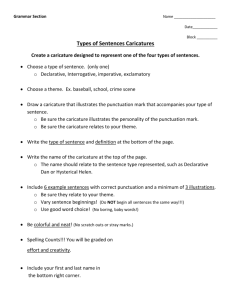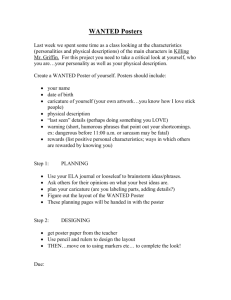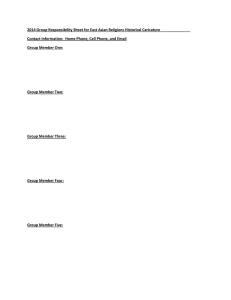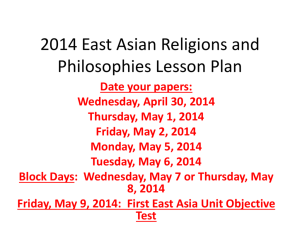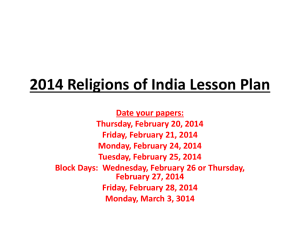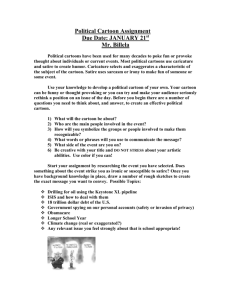The Significance of Caricature in Visual Communication Baran Sarıgül
advertisement
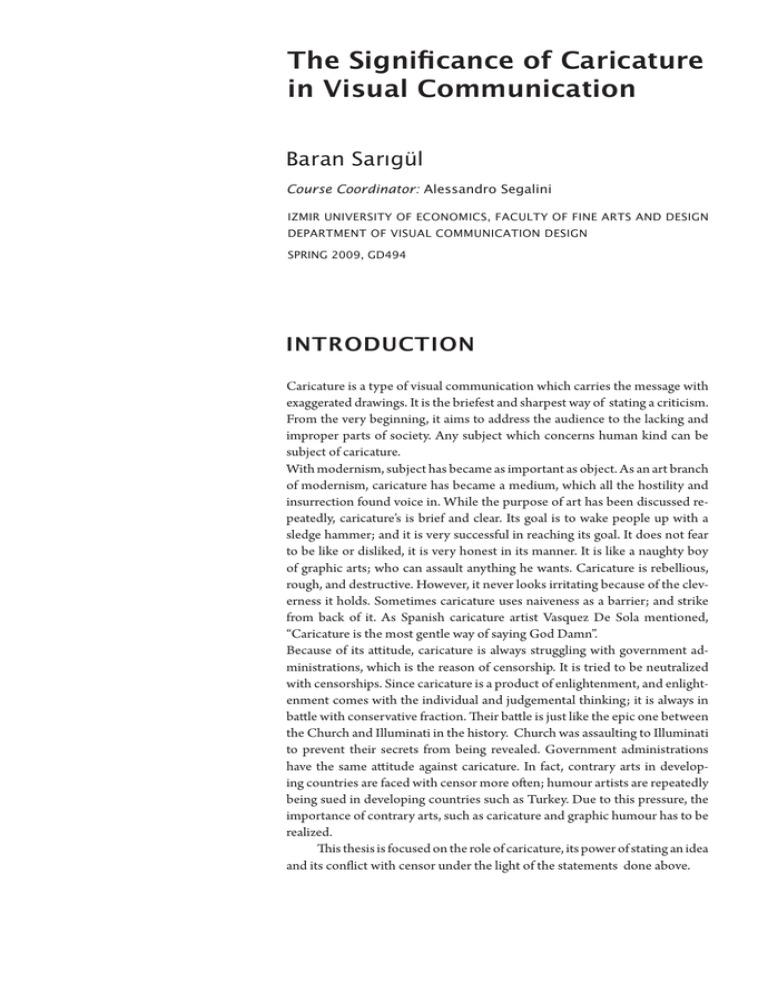
The Significance of Caricature in Visual Communication Baran Sarıgül Course Coordinator: Alessandro Segalini IZMIR UNIVERSITY OF ECONOMICS, FACULTY OF FINE ARTS AND DESIGN DEPARTMENT OF VISUAL COMMUNICATION DESIGN SPRING 2009, GD494 INTRODUCTION Caricature is a type of visual communication which carries the message with exaggerated drawings. It is the briefest and sharpest way of stating a criticism. From the very beginning, it aims to address the audience to the lacking and improper parts of society. Any subject which concerns human kind can be subject of caricature. With modernism, subject has became as important as object. As an art branch of modernism, caricature has became a medium, which all the hostility and insurrection found voice in. While the purpose of art has been discussed repeatedly, caricature’s is brief and clear. Its goal is to wake people up with a sledge hammer; and it is very successful in reaching its goal. It does not fear to be like or disliked, it is very honest in its manner. It is like a naughty boy of graphic arts; who can assault anything he wants. Caricature is rebellious, rough, and destructive. However, it never looks irritating because of the cleverness it holds. Sometimes caricature uses naiveness as a barrier; and strike from back of it. As Spanish caricature artist Vasquez De Sola mentioned, “Caricature is the most gentle way of saying God Damn”. Because of its attitude, caricature is always struggling with government administrations, which is the reason of censorship. It is tried to be neutralized with censorships. Since caricature is a product of enlightenment, and enlightenment comes with the individual and judgemental thinking; it is always in battle with conservative fraction. Their battle is just like the epic one between the Church and Illuminati in the history. Church was assaulting to Illuminati to prevent their secrets from being revealed. Government administrations have the same attitude against caricature. In fact, contrary arts in developing countries are faced with censor more often; humour artists are repeatedly being sued in developing countries such as Turkey. Due to this pressure, the importance of contrary arts, such as caricature and graphic humour has to be realized. This thesis is focused on the role of caricature, its power of stating an idea and its conflict with censor under the light of the statements done above. 08-09 GD494 GRADUATION THESIS CONTENTS iii INTRODUCTION iv TABLE OF CONTENTS vi CHAPTER vii 1. THE DEFINITION OF CARICATURE 3 1.1 What is Caricature 5 1.2 The History of Caricature 7 2. CARICATURE IN TURKEY 8 3. TECHNIQUES USED IN CARICATURE 8 3.1 Reversing 8 3.2 Contrast 9 3.3 Assimilation 9 3.4 Intertextualıty 10 4. CARICATURE AND CENSORSHIP 12 5.CONCLUSION 13 REFERENCES 2 08-09 GD494 GRADUATION THESIS 1. DEFINITION OF CARICATURE 1.1 WHA T IS CA R ICA T U R E ? Caricature (Cartoon) is a line art which has judgemental and critical content; intended to adress a specific problem with exaggerated drawings. Exaggeration is a key term in the definition of Caricature. It takes attention of the audience with an absurd situation and address the problem which it is supposed to (fig 1.). Caricature is not only about drawing funny looking faces. Those faces, which are highlighting a person’s characteristics are parts of caricature for sure; but it is not as technical as it seems. First of all, caricature is a type of visual communication. As all the communication media do, caricature carries a message from sender to receiver. Figure 1: Angel Boligan 1. Charlie Hebdo is a French satirical political weekly newspaper, successor of Hara-Kiri, created in 1960. Its editor is currently Philippe Val. It has a strongly left-wing and anarchist slant. The magazine is respected as being nonconformist and liberal, and remains symbolic of the press having a certain freedom of tone. 2.Punch was a British weekly magazine of humour and satire published from 1841 to 1992 and from 1996 to 2002. Punch material was also collected in book formats as early as the 1800s, including Pick of the Punch annuals with cartoons and text features, Punch and the War a 1941 collection of WWII-related cartoons, and A Big Bowl of Punch which was republished a number of times. 3. Puck was America’s first successful humor magazine of colorful cartoon caricatures and political satire of the issues of the day. It was published from 1871 until 1918. As different from other genres of visual communication, caricature is intended to send humoristic and satirical messages; which are pointing the lacking parts in a society. It is obvious that the term “Humour” does not belong to graphic arts only. It is also an element of literature as well. But since seeing is the most effective and permanent perception among the others, graphic arts are the most affective medium in order to gain the benefits of humour. As painter Abidin Dino stated, “ As a weapon, caricature is much more stronger than a poem or a painting. In order to reach masses, it should be realized that caricature is the shourtcut in order to say something”. Caricature is fierce, offensive, rebellious and destructive. It is like a naughty boy of graphic arts; who can assault anything he wants. This ferocity does not make you irritated because of the smart sense of humour and the brilliance within. We need to differentiate caricature from graphic humour at this point. The word “Caricature” comes from “Caricare” which means to load. Caricature’s subjects are daily. A regular daily sport, magazine or political issue may become the subject of caricature. They are just valid for a short period. Since the subjects vanish, (because of being daily), their jokes vanish as well. They may even become unrecognizable within a week. For Turkey, Uykusuz and Penguen; for France, Charlie Hebdo1; for England, Punch2; and for USA, Puck3 are some examples for caricature magazines. By contrast, graphic humour does not deal with popular issues. Its subjects are not temproary. When you read a political caricature, you have to be familiar with that context in order to understand the joke. Graphic humour contacts with audience by basic semantical meanings; which makes it understandable across globally. Because of this aspect, the examples of graphic humour are almost unlettered while the caricatures are. Works of graphic humour take place in exhibitions rather than newspapers or magazines. 3 08-09 GD494 GRADUATION THESIS With those properties, graphic humour may be considered as a permanent art. The examples from graphic humour from the early 20th century are still as impressive as the date they were first published. Caricature and cartoon are considered as the same thing. In some countries, caricature is still used for exaggerated face drawings only. A caricature artist should be smart, sensible and wise and equiped with the talent of wit. He\ she should follow every current event in the world and should have a wide variety of knowledge. As Turkish caricature artist Ramiz Gökçe mentioned, ‘‘ No one should enter the profession of caricature without knowing from elephant’s tail to Churchill’s cigar; flower of aubergine to the Indonesian flag’’. Caricature also contains psychological analyses. A caricature artist examines the absurdness in social environment and makes psychological statements which are going to be transferred on paper. As Dutch caricature artist Peter Nieuwendijk stated, “Caricature is an artistic psychology”. The tools of caricature are inking pen and ink (fig 2.). With dipping the pen into the bottle, the ink is applied on paper. The lines get thicker as it is pressed more. The combination of thin and thick lines gives the eye-catching structure of a caricature. A caricaturist should avoid excessive lines; which can shade the meaning of the caricature. The lines should come along with the meaning. It is obvious that with the developing digital media, the art is almost transferred from canvas to screen. This is also valid for caricature; but it is not as affected as other art branches. Today, most of the caricatures are done traditionally with pen and ink. There is not a standard way of using inking pen. Every caricaturist has his\her own style. Turhan Selçuk’s4 lines are sharp and constructional (fig 3.); while Cemal Nadir’s5 are naive and rounded (fig 4.). Figure 2: Inking Pen and Ink 4.Turhan Selçuk borned in 1922. He is one of the leading caricature artist of Turkey. With Semih Balcıoglu and Ferit Öngören, He established the Association of Caricaturists in Turkey. 5. Cemal Nadir borned in 1902. Another leading Turkish caricaturist. Creator of the characters like ”Amcabey”, “Efruz Bey”, “Dalkavuk”, “Akla Kara”, “Yeni Zengin”. Figure 3: Turhan Selcuk Figure 4: Cemal Nadir 4 08-09 GD494 GRADUATION THESIS 1.2 THE H IS T OR Y OF CA R ICA T U R E The first examples of caricature are reaching to early Neolithic Ages. Many research specialists agree on that an old drawing which was found in Ti-nLalan of Fisan (fig.5) is the first attempt of drawing a caricature. When we come to Middle Age, we learn that ironically all the caricature looking drawings and sculptures were ordered by Church. Maybe Church’s purpose was to show people, what are they going to become if they don’t obey the rules of the Church Figure 5: A rock drawing from Ti-n-Lalan When we come to Renaissance, the Grotesque6 drawings of Leonardo Da Vinci (fig 6.) are also considered as an attempt for caricaturistic drawings. While all Renaissance artists were following the ideal beauty of human body, Da Vinci was also interested in drawing ugly looking faces. Some of his figures were used to have exeggerated facial properties . That’s what makes his drawings closer to caricature. Figure 6: Grotesque faces of Da Vinci Baroque painter, Annibale Caracci7 (1560-1609), introduced the caricature as a distinct art form. During his time his colleagues created trendy portraits which were as beauty as possible; Caracci moved his work in the opposite direction. Called the antithesis of beauty, his portraits were looking crooked. 6.Grotesque: In modern English, grotesque has come to be used as a general adjective for the strange, fantastic, ugly, incongruous, unpleasant, or bizarre, and thus is often used to describe weird shapes and distorted forms 7. Annibale Carracci (November 3, 1560 July 15, 1609) was an Italian Baroque painter. All those examples that are given so far are not fulfilling the actual meaning of caricature in modern sense. Because they were not done with the aim of making humour. They are drawings which evoke the impression of caricature only. As mentioned before, caricature is intended to address a specific problem. This task has been loaded on caricature with the development of media, democracy and the human conscious. The earlier drawings just formed a baseline for modern caricature. 5 08-09 GD494 GRADUATION THESIS The first examples of actual caricature were made in the late 18th and early 19th centuries (fig 7.). In those years, the word “Satire”8 has integrated in the discipline of caricature and caricature has achieved its contemporary identity. In the years of World War II, with the growing race of propaganda, the actual strength of caricature has been realized as well with graphic design (fig 8.). The artists of each allied countries got united and created numerous striking caricatures and posters. Graphic design and caricature were like embedded on each other. Figure 7: A political satire from early 19th century Figure 8: Caricature example from World War II 8. Satire is often strictly defined as a literary genre or form; although, in practice, it is also found in the graphic and performing arts. In satire, human or individual vices, follies, abuses, or shortcomings are held up to censure by means of ridicule, derision, burlesque, irony, or other methods, ideally with the intent to bring about improvement. Although satire is usually meant to be funny, the purpose of satire is not primarily humour in itself so much as an attack on something of which the author strongly disapproves, using the weapon of wit. In later years, the art of caricature began to institutionalize. All newspapers began to spare space for caricaturists within their structure. With the growing technology, works began to move across the world so rapidly. With the usage of internet, the transportation of information and image have became incredibly fast. This makes the jokes of caricatures to be understood easier; because people began to get familiar with every icon and metaphor which were used. The caricature artists worry of being understood has diminished and the battle of caricature artists against the absurdness in life continues from that time up to now. 6 08-09 GD494 GRADUATION THESIS 2. CARICATURE IN TURKEY The first humour magazine in Anatolia is called Diyojen; which was published in Ottoman Empire by Teodor Kasap of Kayseri10 in 1870 (fig 9.). It lasted for three years. During this period, it was closed temporarily for three times and sadly it was closed permanently because of the political satire it had. Afterwards, dozens of humour magazines published and closed. This wind continued after the establishment of Republic of Turkey. We need to highlight Gırgır among the other magazines. Gırgır changed the perception of caricature in Turkey; which was decreasing dramatically (1972)(fig 10.). Figure 9: A political satire from Diyojen 10. Teodor Kasap: Borned in Kasyeri in 1835. He was a journalist and author in Ottoman Empire whose origin was Greece. 11. Oguz Aral:Born in Silivri, Istanbul, he founded the cartoon magazine Gırgır (Fun) with his brother Tekin Aral, and created such characters as “Avanak Avni” (Avni the Gullible), “Köstebek Hüsnü” (Hüsnü the Mole), “Utanmaz Adam” (the Shameless Man) and “Vites Mahmut” (Mahmut the Gearbox). Called the “godfather” of Turkish cartoonists, Aral mentored scores of young artists, helping them publish their comics. Gırgır, known to be outstandingly critical of all social ills, was banned after the 1980 military coup, but Oguz Aral’s cartoons still ran in the newspaper Hürriyet until his death in Bodrum. Figure 10: A cover of Gırgır The cause of this decrease was the humour magazines which were full of cheap jokes and naked women. They were fooling people instead of waking them up. Gırgır was looking like one of them in the time it was first published. But within the years of 1975 and1980, the magazine found its actual political identity with the leading of Oğuz Aral11. He raised a generation of caricaturists who were smart and talented. With a master and apprentice attitude, the magazine became the one, which had the loudest voice in the country. This success was not only limited within the borders of Turkey. Gırgır was the third top seller humour magazine across the world in 80’s. Even in the martial law of 80’s, it did not changed its stand and kept on being the only voice of contrary fraction. There is an ongoing tradition that when newbie drawers become professional, they leave their magazines to form a new one. It is like a law which is set by mother nature. From 1986 to 1989, the magazine hemorrhaged because of the leaving artists; and later the magazine was sold to a different owner and the era of Gırgır had closed. Afterwards, this split has continued till today’s humour magazines such as Uykusuz and Penguen. 7 08-09 GD494 GRADUATION THESIS 3. TECHNIQUES USED IN THE ART OF CARICATURE 3.1 RE V E R SING This technique i s basically about taking a well known situation or an item and reversing it to achieve a humoristic sense. As shown in figure 11, Angel Boligan reversed the television with the brain Figure 11: Example for reversing 3.2 CONT R A S T It is a bread and butter technique in caricature. It is based on shocking the audience by using number or size contrast. As in figures 12 and 13, size and number contrast was used for boosting the meaning. Michael Ramires’s12 works are good examples in terms the application of contrast. Figure12: Example for size contrast 13. Michael Patrick Ramirez (born May 11, 1961) is a two-time American Pulitzer Prize-winning editorial cartoonist. His cartoons typically present conservative viewpoints. Ramirez initially planned to study medicine in college and considered journalism a hobby. He became seriously interested in that field when his first cartoon for the college newspaper, lampooning candidates for student office, had the student assembly demanding an apology. Figure 13: Example for number contrast 8 08-09 GD494 GRADUATION THESIS 3.3 ASS IM IL A T ION This technique is about assimilating a situation in order to load the property of the thing, which is adressed. As shown in figure 14, Patrick Chappette assimilated the circles of the olympics game’s symbol to palette of a tank in order to load the meaning of the tank to the olympic games. Figure 14: Example for Assimilation 3.4 IN T E R T E XT U A L IT Y 13. Patrick Chappatte (known simply as Chappatte in his cartoons) is a Lebanese-Swiss cartoonist who draws for Le Temps, Neue Zürcher Zeitung (Sunday edition) and the International Herald Tribune. He is a prototypical global citizen, from a Lebanese mother and a Swiss father, born in Karachi, Pakistan in 1967, but raised in Singapore and Switzerland, he also worked as an illustrator for the New York Times and as cartoonist for Newsweek. Many of his cartoons reflect events in Swiss and international news, such as the 9/11 attacks, the rise of the Swiss People’s Party, and the Israeli-Palestinian conflict. 14. Guernica is a painting by Pablo Picasso, depicting the bombing of Guernica, Spain, by German and Italian warplanes at the behest of the Spanish Nationalist forces, on April 26, 1937 during the Spanish Civil War. Guernica shows the tragedies of war and the suffering it inflicts upon individuals, particularly innocent civilians. This work has gained a monumental status, becoming a perpetual reminder of the tragedies of war, an anti-war symbol, and an embodiment of peace. On completion Guernica was displayed around the world in a brief tour, becoming famous and widely acclaimed. This tour helped bring the Spanish civil war to the world’s attention. Intertextuality is one of the most popular techniques in all media of visual communication of postmodern world. It is based on creating a new meaning by refering to existing texts and contexs; by assuming that the viewer is familiar with those texts and contexts. It is used in wide variety of media; from sit-coms to advertorial posters. Caricature is also getting its share from this technique. As shown in figure 15, Angel Boligan took Guernica13; and converted the suffering people into fighting hooligans in order to adress the problem of hooliganism in football. Figure 15: The Guernica and the Caricaturists interpretion 9 08-09 GD494 GRADUATION THESIS 4. CARICATURE AND CENSORSHIP Obviously, with the all satire caricature has, it is subjected to reactions from various institutions and individuals. Unavoidably this brings censorship at the end; which may lead to be closed temporally or sometimes entirely. Censor, with its basic meaning, is a supervision over every single publication from television to magazine. All the units of publications are controlled in order to check if they are publishable or not. This means it is the government who decides what we can watch or read. There are numerous reasons what brings censor. The major ones are pornography, violence and swearing. When we come to censorship on caricature, this is where things become ridiculous. When you censor a caricature, you also censor the individual thinking behind it. This is a more serious situation then preventing the children from learning swear words or seeing naked women. This effort is not for protecting the social manner; they are just for protecting some ones wallet or benefits. Because all those striking caricatures are destructing the reputation of some individuals or institutions. Since caricature is a product of enlightenment, those censors are nothing but a primitive effort to shade judgemental thinking. This conflict is just like the one between an ancient brotherhood, Illuminati and the Church. Illuminati was exalting science and fighting against the dogmas of the Church. Their aim was to illuminate people by the science oriented doctrines. The existence of the brotherhood was wounding the Church badly. This was not acceptable for them and they started to hunt the members down. 15. Illuminati (plural of Latin illuminatus, “enlightened”) is a name that refers to several groups, both historical and modern, and both real and fictitious. Historically, it refers specifically to the Bavarian Illuminati, an Enlightenmentera secret society founded on May 1, 1776. We can easily say that this attitude is still valid for today. Caricature artists are revealing the actual aspects of institutions and individuals; and they are subjected to censor. Under this pressure, a caricature artist is supposed to state their satires without being subjected to any reaction. Obviously this depends on how intelligent and tricky the artist is. Censorship is applied much more in the developing countries because developing countries are not yet reached to a contemporary society. We get used to the news which are about the caricature artists that are sued. But they forgot one thing . With censorship, they take all the attention to the accused caricature and cause curiosity; which makes everybody curious and search for that censored publication; and makes the artists to reach their goal easily. Struggling with caricaturists can be pretty risky. Because when they got united, an incredible power of satire unleashes; and this power can ruin your repetition in a week. There is a wonderful example, which took place in Turkey. Musa Kart1 of Cumhuriyet, represented The Prime Minister Recep Tayyip Erdoğan; as a kitten playing with a ball of wool.(fig16) This caused him to be sued. One week later, Penguen was published with a title of “The realm of Tayyips” which refered to “Realm of Animals”. At the cover, every artist in Penguen represented Tayyip Erdoğan as a different animal(fig.17). This is a marvelous example to see the caricaturists stand and their reaction against censorship. Musa Kart’s caricature brought him the courage award from The Foundation of Caricaturist’s Rights in California. 10 08-09 GD494 GRADUATION THESIS Figure 16: The Kitten caricature which was subjected to sue. Says: “No need to stress; we gave promise to solve this” 16. George Cruikshank: (27 September, 1792 – 1 February, 1878) was an English caricaturist and book illustrator, praised as the “modern Hogarth” during his life. Born in London, he was a member of the Cruikshank family of caricaturists and artists, the son of Scottish painter and caricaturist Isaac Cruikshank. 17. The Salem witch trials were a series of hearings before local magistrates followed by county court trials to prosecute people accused of witchcraft in Essex, Suffolk and Middlesex counties of colonial Massachusetts, between February 1692 and May 1693. Over 150 people were arrested and imprisoned, with even more accused but not formally pursued by the authorities. The two courts convicted twenty-nine people of the capital felony of witchcraft. Nineteen of the accused, fourteen women and five men, were hanged. One man (Giles Corey) who refused to enter a plea was crushed to death under heavy stones in an attempt to force him to do so. At least five more of the accused died in prison. Figure 17: Penguens cover relevant to this subject In 19th century, it was the royal family who was the source of censorship. In 1820, George Cruikshank16 created political caricatures that was teasing with the royal family and leading politicians; and he charged for a bribe of £100 for a pledge “not to caricature his Majesty (George III of the United Kingdom) in any immoral situation.” Obviously, the tolerance of censorship differs from country to country. There may have been no reaction to a caricature like this one in Europe. In modern societies, caricature is an exalted art application. Editors of newspapers respect their artists’ thoughts; and publish their works even if the caricatures have conflicting ideology with the newspaper. In underdeveloped countries, caricature is seen as an invention of evil by governments. It can be said that those ongoing trials are very similar to Salem Witch Trials17 which took part in late 17th century. From that time up to now, censorship is always at the side who is keeping the money and power in hand. As said in a proverb, “Censorship does not touch crows; it murders pigeons’’ It should be really realized that, this attitude against individual thinking belongs to the darkness of Middle Age. If we are claiming that the age that we live is a modern one, this pressure has to be stopped. 11 08-09 GD494 GRADUATION THESIS CONCLUSION Statements that are made so far highlighted the properties of caricature with all its aspects. From the beginning of humanity, from cave walls to postmodernism, people searched for ways to represent themselves and their nature. Caricature came with the age of enlightenment, and remunerated the age it belongs; with its stand and its judgemental attitude. As an art branch of modernism, caricature has reminded us that pen is mightier than sword and became the visual yelling of societies. 12 08-09 GD494 GRADUATION THESIS REFERENCES Hifzi Topuz, The World Caricature from Start to Today, Anadolu Üniversitesi Basımevi.(1986) İsmail Kar, The Art of Caricature, Kültür Bakanlığı Yayınları. (1999) Önder Şenyapılı, Caricature : What, Why and How it Represents; Who Draws Why?, ODTÜ Yayıncılık. (2003) Turgut Çeviker, Writings about Caricature, İris Yayıncılık. (1997) Önder Şenyapılı, Caricature and Communication, Karikatür Vakfı Yayınları. (1999) Turhan Selçuk, Graphic Humour, İris Yayıncılık. (1998) 13

